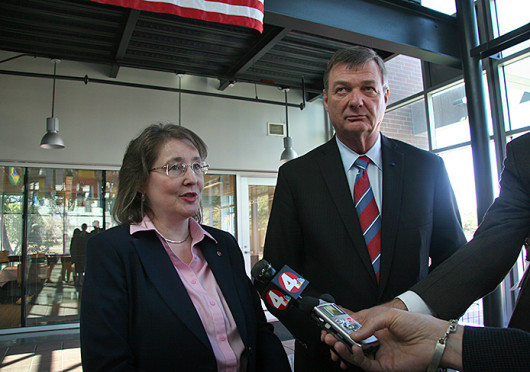
OSU Presidential Search Committee advisory subcommittee convener Deborah Jones Merritt (left) and Search Committee Chair Jeffery Wadsworth speak at a meeting Sept. 17.
Credit: Liz Young / Campus editor
When Presidential Search Committee Chairman Jeffrey Wadsworth said July 19 the process to find a new president would take roughly 300 days, details were few and far between about what the specific process would entail. Though some of those details — the contract with a private search firm, the cost of holding the Symposium on the University Presidency, the names of suggested candidates — have since emerged, the most important aspect remains a question mark.
Who are the actual candidates?
OSU spokespeople have said all candidates, including finalists, will be kept confidential. With other universities, including Louisiana State University, facing lawsuits for their extreme measures to keep potential presidents private, it seemed alarming to The Lantern staff at first that OSU was heading down a similarly shady path. After all, former OSU President E. Gordon Gee made involvement with the OSU community such a high priority that it seems there wouldn’t be many cons to having that community “approve” the finalists.
Until we learned that apparently with the way these searches work, the highest quality candidates expect confidentiality. If the search was open to the public, OSU wouldn’t be looking at prominent, well-known and loved higher education leaders, but at those who are undeniably good at their jobs but aren’t great. The beloved president of another university could be putting his or her job at risk by being named as a contender at OSU.
Obviously the search committee and other higher-ups at OSU have decided the risk of getting someone less than the best isn’t worth it and that’s why the search is private. But the question then becomes whether or not the university community should support the choice to keep the search from the eyes of the public.
As The Lantern staff sees it, there are two sides. On the one hand, we all want a president who can lead effectively and efficiently, who is willing to listen to feedback from students, faculty and staff and who has a commitment to transparency.
On the other hand, given the context about the events leading up to Gee’s retirement, which was announced after controversial comments made at a Dec. 5 athletics council meeting became publicly criticized, it seems like OSU might dig itself into a deeper hole by being secretive. Although the Presidential Search Committee has been soliciting suggestions from the public via a website and various open forums, without a true process of approval from the community at large, there isn’t a way to be sure the person chosen is the best for everyone and not just the best for the administration.
After 94 days of the search with roughly 200 days left in the given timeframe, the path looks like it will get gradually less transparent from here. Whether that will hurt or help the university as a whole, though, remains to be seen.


